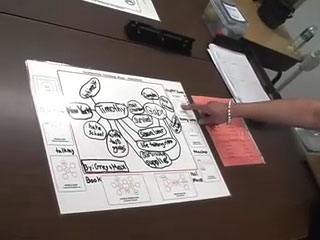



Learning Prep: Visual Tools
West Newton, Massachusetts
A relevant issue to explore is how Thinking Maps differ from other visual tools, including graphic organizers and brainstorm webs. Graphic organizers are geared towards isolated tasks, as they are highly structured and task-specific; students simply are required to fill-in a worksheet. Webs are more flexible than graphic organizers, allowing the student to record personal knowledge about a topic in an adaptable format. Thinking Maps combine the task-specific structure of a graphic organizer with the flexibility of a web, enabling the student to transfer thinking processes and develop a common visual language that is shared by other students and teachers (Hyerle and Curtis, 2001).

Elaine, the language arts reading teacher at Learning Prep, is interviewed.
![]() Watch the video clip in Quicktime (12:28)
Watch the video clip in Quicktime (12:28)
What exactly does this mean? Thinking Maps are based on the eight fundamental thinking skills that everyone possesses: define, describe, compare and contrast, classify, divide a whole into parts, sequence, cause and effect, and see relationships. Once students master these eight thinking skills, they are taught how to apply these thinking processes in order to solve problems using Thinking Maps; students then are able to transfer thinking skills across content areas. Thinking Maps are especially unique because, unlike graphic organizers and webs, maps can be used by teachers to teach lessons, they can be used by students as a learning activity, and they can be used as reflective or developmental learning assessment tools by students and teachers alike. Thinking Maps alone develop higher level, critical thinking skills because they complement and promote the eight thinking processes. A student does not just record information-he or she comprehends and manipulates it using metacognitive skills, i.e., a student is required to think about thinking in order to understand and complete the map (Hyerle and Curtis, 2001). 'The consistency and flexibility of each of the Thinking Maps promotes studentcentered and cooperative learning, concept development, reflective thinking, creativity, clarity of communication, and continuous cognitive development" (Hyerle, 1995, 89).
Download the Improving Reading Comprehension Through Visual Tools Thesis by Cynthia Manning
- Thesis Summary (pdf file)
- Complete Thesis (pdf file)